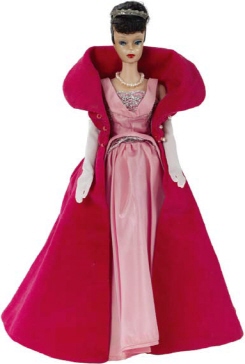
Warman's
Barbie Doll

FIELD GUIDE
2nd Edition

Edited by Paul Kennedy
Values and Identification
Copyright 2009 Krause Publications, Inc.,
a subsidiary of F+W Media, Inc.
All rights reserved. No portion of this publication may be reproduced or transmittedin any form or by any means, electronic or mechanical, including photocopy,recording, or any information storage and retrieval system, without permission inwriting from the publisher, except by a reviewer who may quote brief passages in acritical article or review to be printed in a magazine or newspaper, or electronicallytransmitted on radio, television, or the Internet.
Published by

700 East State StreetIola, WI 54990-0001
715-445-2214 888-457-2873
www.krausebooks.com
Our toll-free number to place an order or obtain
a free catalog is (800) 258-0929.
The word mark BARBIE and associated trademarks are owned by Mattel Inc. and are used in this book solely for identification purposes. Mattel Inc. assumes no responsibility for the content of this book. The publisher is not sponsored by or associated with Mattel Inc. or its affiliates. This book is a result of independent research reporting on the secondary market and is intended to provide information for collectors.
Special thanks to Sandi Holder for photo contributions from her collection. Sandi is the owner of Sandi Holders Doll Attic (www.dollattic.com).
Cover photography by Kris Kandler
Library of Congress Control Number: 2008937693
ISBN 13: 978-0-89689-700-7
ISBN 10: 0-89689-700-1
eISBN: 978-1-44021-920-7
Design by Rachael Knier
Edited by Paul Kennedy
Printed in China
CONTENTS
A STAR IS BORN
BARBIE SHINES BRIGHTEST IN DOLL GALAXY

By combining a sense of fashion with unlimitedpotential, Barbie doll quickly became an instant hit.
Little could Ruth Handler have realized her first attempt at dollmaking would help create not only a fabulous doll, but also a touchstone of cultural politics and one of the most amazing success stories in the history of childrens toys. Not bad for a woman who was simply trying to give her daughter something fun to play with.
With Handler as the catalyst, Mattels first Barbie doll named after Handlers daughter, Barbara debuted at the American Toy Fair in New York City in 1959. The 11 1/2-inch, fresh-faced doll with a ponytail and a black-and-white striped swimsuit became an instant hit, selling more than 350,000 units its first year.

Ruth Handler

A "Busy Girl" outfit on a Ponytail #5 Barbie doll.
Since then, more than 1 billion Barbie dolls have been sold in 150 countries. First introduced as a teenage fashion model, Barbie has enjoyed an endless and varied career path in the past five decades. Shes been everything from an astronaut to a paleontologist to a presidential candidate.
My whole philosophy of Barbie was that through the doll, the little girl could be anything she wanted to be, Handler wrote in her 1994 autobiography, DreamDoll: The Ruth Handler Story. Barbie always represented the fact that a woman has choices.
Over and over I've had it said to me by women she was much more than a doll for them. She was part of them, Handler, who with her husband Elliot launched Mattel in 1945, told The Associated Press.
Before her death in 2002 at the age of 85, Ruth Handler fashioned not only a wonderful toy for little girls, but also one of the most popular and prized collectibles in the toy market. A Ponytail Barbie doll # 1 has sold for as much as $25,000 in mint condition. Not bad for a doll that originally sold for $3.

Sophisticated Lady fashion set debuted in 1963.
Part of the reason Barbie has reached such amazing value on the secondary market is that over time the doll has become woven into the fabric of our society. Consider that in 1976, as the country celebrated its Bicentennial, Barbie doll was placed in the official Americas Time Capsule so future generations would be ensured the pleasure of her acquaintance.
Its important to remember Barbie dolls birth came in the 1950s, a time when Americans reaped the benefits of a strong, postwar economy. We liked Ike in the White House and Milton Berle on TV. Ben-Hur commanded Best Picture recognition, while teen idols like Fabian and Frankie Avalon broke hearts. Alaska and Hawaii joined the Union, and Detroits new cars featured big, bold tailfins.
In this backdrop the baby boom generation took shape, and so did Barbie doll.

A Ruth Handler autographed Barbie doll booklet.
The inspiration for Barbie came as Handler watched her daughter, Barbara, playing with paper dolls. Barbara and her friends liked to play adult or teenage make-believe with the paper dolls, imagining them in roles as college students, cheerleaders and adults with careers. Handler recognized that experimenting with the future from a safe distance through play was an important part of growing up. She also noticed a void and was determined to fill that niche with a three-dimensional fashion doll.
Over the years, Barbie doll has indeed achieved the title of the most popular fashion doll ever created. Shes held that title by changing with the times. With fashion and teenage lifestyle trends evolving at a startling rate, Mattel had its hands full keeping the doll current. Styles changed dramatically from Paris couture to the inspired elegance of the Jackie Kennedy years of the early 1960s to a more free-flowing, youthful look of the late 1960s.
When, in 1964, the Beatles led the British Invasion and, along with a new sound, brought hemlines way up and hair way down as teenagers adopted the Carnaby Street look. Barbie went Mod a few years later with new face sculpting in 1967, which brought her current with the next generation of little girls.

Style mattered when carrying the most famous doll couple.
In the 1970s, Barbie wore up-to-the-minute fashions reflecting the prairie look, the granny dress, the California Girl suntan craze and the glittery styles of the disco years. By the end of the decade, Barbie dolls face was again re-sculpted to a wide smile and sun-streaked hair showcasing the beauty trends of the day.
Next page




















